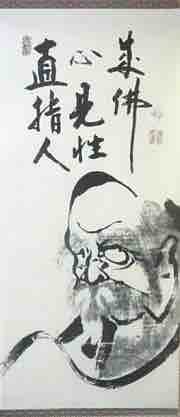Overview: Zenga Painting
Zenga is the Japanese term for the practice and art of Zen Buddhist painting and calligraphy; it is associated with the Japanese tea ceremony and also various martial arts. As a noun, Zenga is a style of Japanese calligraphy and painting done in ink. In many instances, both calligraphy and image will be merged within the same piece. The calligraphy denotes a poem or saying that teaches some element of the path of Zen; the brush painting is characteristically simple, bold, and abstract.

Example of Zen painting, Edo period
This Japanese scroll calligraphy of Bodhidharma reads: "Zen points directly to the human heart, see into your nature and become Buddha". It was created by Hakuin Ekaku (1685 to 1768).
Development of Zenga
Though Zen Buddhism had arrived in Japan at the end of the 12th century, Zenga art didn't come into its own until the beginning of the Edo period in 1600. In keeping with individual paths to enlightenment, nearly any subject matter can and has lent itself to Zenga; however, the most common elements depicted were the ensō, sticks, and Mt. Fuji. In Zen Buddhism, an ensō is a circle that is hand-drawn in one or two uninhibited brushstrokes to express a moment when the mind is free to let the body create. The ensō symbolizes absolute enlightenment, strength, elegance, the universe, and mu (the void), and it is characterized by a minimalism born of Japanese aesthetics.
Enso
Though nearly any subject matter can and has lent itself to Zenga paintings, one of the most common elements depicted was the ensō, a symbol of enlightenment.
Japanese aesthetics used in Zenga paintings were shaped by a set of ancient ideals that include wabi (transient and stark beauty), sabi (the beauty of natural patina and aging), and yūgen (profound grace and subtlety). These ideals, along with others, underpin much of Japanese cultural and aesthetic norms on what is considered tasteful or beautiful. Japanese aesthetics now encompass a variety of ideals; some of these are traditional, while others are modern and sometimes influenced from other cultures.